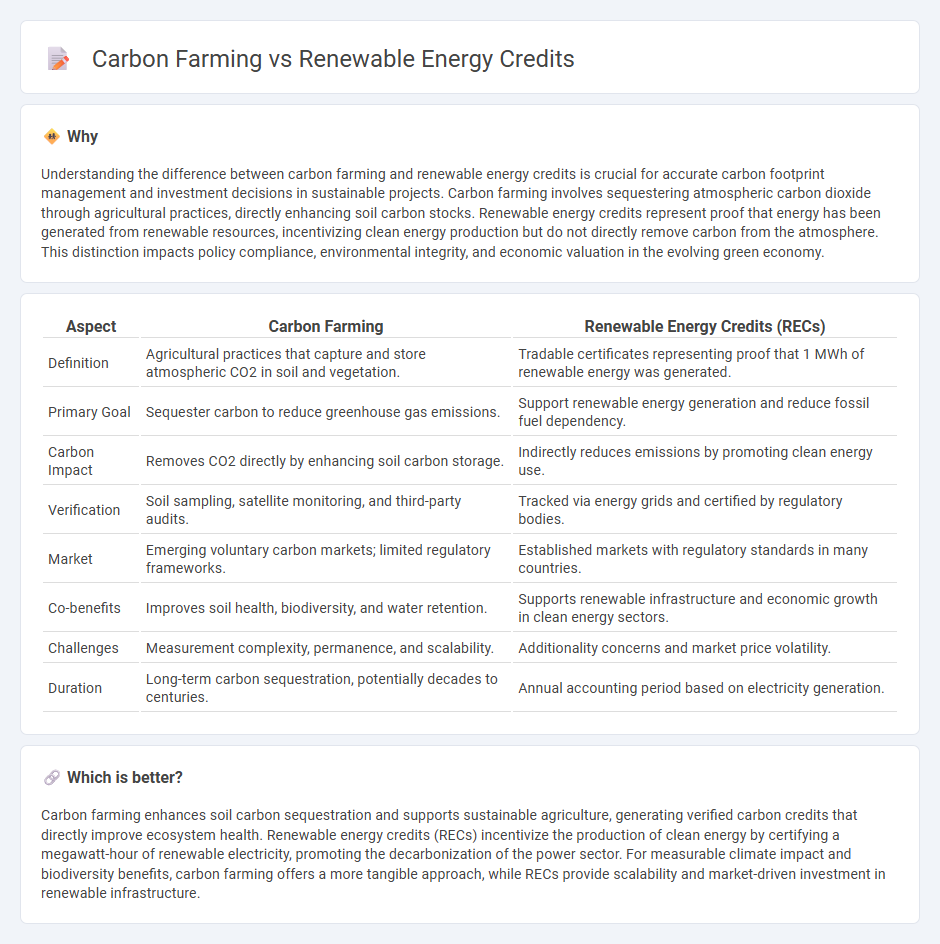
Carbon farming enhances soil carbon sequestration by promoting sustainable agricultural practices that capture atmospheric CO2, offering verified environmental benefits. Renewable energy credits (RECs) represent proof that electricity has been generated from renewable sources, providing a market-based mechanism to incentivize clean energy production and reduce greenhouse gas emissions. Explore the distinct economic impacts and opportunities of carbon farming versus renewable energy credits to understand their roles in climate finance.
Why it is important
Understanding the difference between carbon farming and renewable energy credits is crucial for accurate carbon footprint management and investment decisions in sustainable projects. Carbon farming involves sequestering atmospheric carbon dioxide through agricultural practices, directly enhancing soil carbon stocks. Renewable energy credits represent proof that energy has been generated from renewable resources, incentivizing clean energy production but do not directly remove carbon from the atmosphere. This distinction impacts policy compliance, environmental integrity, and economic valuation in the evolving green economy.
Comparison Table
| Aspect | Carbon Farming | Renewable Energy Credits (RECs) |
|---|---|---|
| Definition | Agricultural practices that capture and store atmospheric CO2 in soil and vegetation. | Tradable certificates representing proof that 1 MWh of renewable energy was generated. |
| Primary Goal | Sequester carbon to reduce greenhouse gas emissions. | Support renewable energy generation and reduce fossil fuel dependency. |
| Carbon Impact | Removes CO2 directly by enhancing soil carbon storage. | Indirectly reduces emissions by promoting clean energy use. |
| Verification | Soil sampling, satellite monitoring, and third-party audits. | Tracked via energy grids and certified by regulatory bodies. |
| Market | Emerging voluntary carbon markets; limited regulatory frameworks. | Established markets with regulatory standards in many countries. |
| Co-benefits | Improves soil health, biodiversity, and water retention. | Supports renewable infrastructure and economic growth in clean energy sectors. |
| Challenges | Measurement complexity, permanence, and scalability. | Additionality concerns and market price volatility. |
| Duration | Long-term carbon sequestration, potentially decades to centuries. | Annual accounting period based on electricity generation. |
Which is better?
Carbon farming enhances soil carbon sequestration and supports sustainable agriculture, generating verified carbon credits that directly improve ecosystem health. Renewable energy credits (RECs) incentivize the production of clean energy by certifying a megawatt-hour of renewable electricity, promoting the decarbonization of the power sector. For measurable climate impact and biodiversity benefits, carbon farming offers a more tangible approach, while RECs provide scalability and market-driven investment in renewable infrastructure.
Connection
Carbon farming generates measurable carbon sequestration that can be quantified to issue renewable energy credits (RECs), linking agricultural practices with the carbon market. These credits incentivize sustainable farming by providing financial value for carbon reduction, integrating environmental goals into economic mechanisms. This connection enhances market-based solutions for reducing greenhouse gas emissions and promotes investment in renewable energy and sustainable land management.
Key Terms
Offsets
Renewable energy credits (RECs) represent proof that electricity was generated from renewable sources, allowing companies to offset their carbon footprint by supporting clean energy projects. Carbon farming involves agricultural practices designed to increase carbon sequestration in soil and vegetation, providing tangible carbon offsets linked to land management. Explore the differences and advantages of RECs versus carbon farming offsets to optimize your sustainability strategy.
Additionality
Renewable energy credits (RECs) represent proof of investment in green energy generation, ensuring additional clean power added to the grid, whereas carbon farming emphasizes additionality through measurable carbon sequestration by altering land management practices. The Additionality principle in both mechanisms certifies that the environmental benefits would not have occurred without the project, highlighting true climate impact. Explore more about how Additionality drives credibility in climate solutions beyond carbon offsetting.
Verification
Renewable Energy Credits (RECs) undergo third-party verification to ensure that each credit corresponds to one megawatt-hour of renewable energy generated, maintaining transparency and accountability in carbon offset markets. Carbon farming verification involves detailed monitoring of soil carbon sequestration, often using soil sampling, remote sensing, and modeling techniques, which requires stringent protocols and periodic assessments to confirm carbon capture. Explore further to understand how verification impacts the credibility and effectiveness of these climate solutions.
Source and External Links
What Are Renewable Energy Credits? RECs Explained - A renewable energy credit (REC) is a market-based instrument representing the environmental attributes of one megawatt-hour (MWh) of electricity generated from renewable sources and delivered to the grid, which can be sold or traded separately from the electricity itself to support clean energy markets and help reduce carbon footprints.
Residential Clean Energy Credit | Internal Revenue Service - The Residential Clean Energy Credit is a U.S. federal tax incentive that offers a credit of 30% of the cost of installing eligible clean energy systems (such as solar, wind, or battery storage) in your home between 2022 and 2032, with the credit rate decreasing after 2032 and no annual or lifetime dollar limit except for fuel cell property.
Renewable energy credit - Wikipedia - Renewable energy credits (RECs) function as certificates representing the environmental benefits of renewable energy, enabling individuals and businesses to claim reductions in conventional energy use and greenhouse gas emissions by purchasing RECs, distinct from government tax credits for renewable energy installations.
 dowidth.com
dowidth.com